At a Glance: Tapestry
Designer: Jamey Stegmaier
Publisher: Stonemaier Games
Artists: Andrew Bosley, Rom Brown (sculpts)
Player Count: 1-5
Suggested Age: 12+
Playing Time: 90-120 minutes
Theme: Civilization
Mechanics: Tech tree, asymmetrical powers, track movement
“The Tapestry. Mend the bond.”
– Princess Merida, Brave

Intro Story
Fire. That’s how all of this started. One spark, one flame, and one civilization. We thought we were the only ones in the world. We thought to make a utopia for ourselves.
We were disappointed.
As we began to expand toward the island off in the distance, we noticed other expeditions. At first we were glad to have more people. That surely meant mutual benefits. We moved up near them and gave greeting. In return, we were toppled by their brutality. We fled back to our capital, but it was too late. They knew we existed, and they found us to be weak. The time had come to focus our efforts, to grow in such a way as to intimidate our foes into keeping their distance.
While military might may not be our speciality, we are intrepid explorers, discovering vast oceans and islands galore. Each new location provides a wealth of resources others would surely kill to have. So, with our abundance in resources, we tinker and invent. Our technology far exceeds that of our new rivals. Unfortunately, their apathy toward killing puts us all in danger.
We can only hope that, as we continue to seclude ourselves, our technology will give us an advantage against the barbarians should they come near our other settlements.
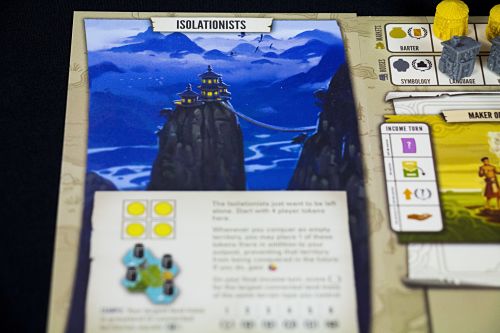
Note: I was provided a complimentary copy of Tapestry for the purposes of review. The thoughts and opinions in this review are my own.
Roadmap
If you’re already familiar with Tapestry, check out the review for the Plans and Ploys expansion!
This review has two parts. First, there is the Short Review, where various aspects of the game are discussed. Then comes the Gameplay Review, in which the setup and gameplay are discussed in detail, along with initial thoughts. Following the Gameplay Review section are some final thoughts and a final verdict of the game. Feel free to jump around, or read it all in one go.
Short Review
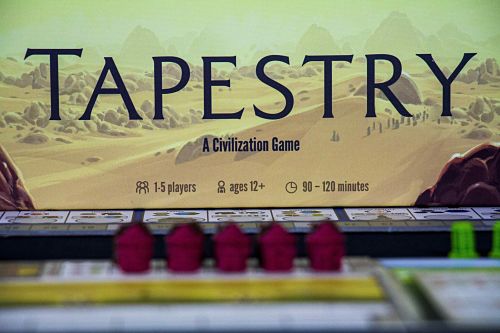
Tapestry is a civilization game, pure and simple. You advance in science, war, exploration, and technology. You choose the tech to develop. You choose which tracks you want to focus on. You choose how your civilization will evolve over time.
Let’s get our civ on!
Immersion
As is usual with Stonemaier Games, the component quality is wonderful. In fact, the building sculpts are pre-painted! The look of the game itself got me excited to play. There really isn’t much of a story, per se, in Tapestry, other than the one you create for your civ as the game progresses. And I like that.
Theme
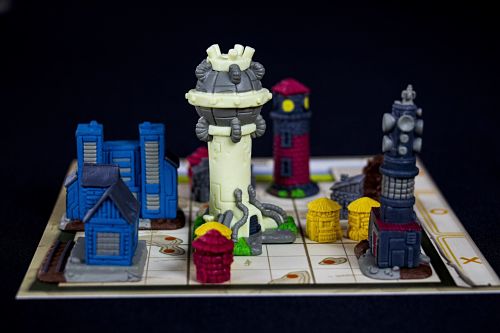
The theme is, well, there. It exists. It’s a civilization game, so you’re growing your civilization from barbarians whose scientific exploits involve making fire to a highly advanced civilization with loads of science, tech, war prowess, and discovery. Civilization games have been around for quite some time (perhaps the most famous being Sid Meier’s series), and they are strong competitors as some of the most addicting video games around. Brought to the table, Tapestry’s iteration of a civilization game is no less enjoyable, if only in different ways.
Components
As mentioned above, the components are wonderful. I’m mainly thinking of the building sculpts, which are pre-painted and add a certain “wow” factor to the game. Unfortunately, the bases of said sculpts are a tad smaller than the area they’re supposed to cover on your board. While this isn’t a huge deal, it can get confusing if you’re not careful.
The board, tokens, dice, and civ/player mats are all good quality. As always, it’s what you’ve come to expect with Stonemaier games.
Standout Performances
- Beautiful buildings
The building sculpts really are nice, and the aesthetic they add to the game can’t be dismissed.
- Quick turns
Assuming everyone has played at least one game previously, the turns can go pretty quickly. That helps reduce downtime, which is always nice.
- Decisions, decisions…
With four tracks to advance on, you’ve got choices. These choices may relate to your starting civilization, to your goal to get to space, or from your opponents’ decisions. Plus more. Each track has much to offer, but also specializes in certain things. You strategy one game can be completely different the next, which is helpful to keeping the game fresh.
- Solo
The Automa in Tapestry is smooth and plays incredibly well. It’s actually become a favorite of mine to play solo. I find the Automa to be quite difficult, but not in a way that makes it no longer fun to play.
Breaking the 4th Wall
In theater, breaking the fourth wall refers to when characters (or something else) directly address the audience, thus pulling them out of the narrative and making the astutely aware that they are, in fact, watching a performance and that’s it’s not actually real.
- The bases of the building sculpts don’t match the grid they’re supposed to fit onto. As they are a bit smaller, it leaves space around it, sometimes confusing me, thinking I haven’t yet filled in certain spaces. It doesn’t hurt the game and it certainly won’t keep me from playing, so this is a minor concern.
- Playing with two players (which is a frequent player count for me) is different, since you don’t get the benefit of both adjacent players. Of course, the Shadow Empire (Shadows of the Empire?) AI can be used in place of a third player, but that’s extra upkeep I don’t always enjoy in a game. Unless it’s solo, in which case I expect to. But, the Shadow Empire/Automa rules are pretty slick, so it’s certainly not a deal breaker.
Gameplay Review
First Impressions
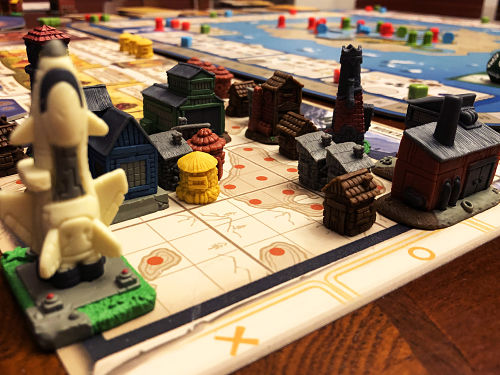
I enjoy civilization games (such as Sid Meier’s Civilization 6, currently), so I was quite interested in Tapestry. It doesn’t necessarily play like the civilization games you may be used to (see Civ 6). This is due in part to progression—meaning, it doesn’t happen like it would in real life. You can start working on blimps while you’ve just barely discovered how to make fire, for example. Or get to space before you’ve explored practically anywhere.
But, to me, the order of things doesn’t really matter. Learning and advancing tech is enjoyable for what it is. And I read enough fantasy to recognize that not every civilization is going to follow the natural steps of progression with exactness. So while the civilization aspect comes across different than what I had originally expected, it still works well.
There is a lot of iconography, which can be intimidating for new players. Heaven knows, my first game was me frequently referring to what each icon represented. That said, it didn’t take long to get the hang of things, and it’s been smooth sailing ever since.
As far as first impressions go, it wasn’t really what I was expecting, but I was still pleasantly surprised.
Setup
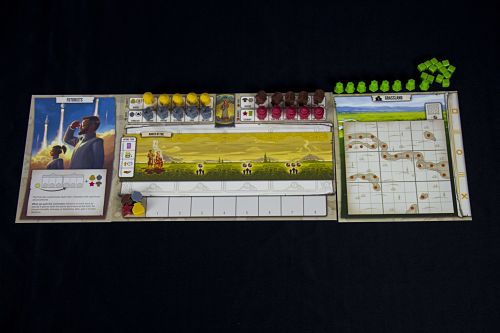
If everyone sets up their own income mats, things will go much faster. Still, there’s not a lot to remember, and everything is fairly intuitive.
The board is double sided, one side being for 1-3 players, and the other side for 4-5 players. Obviously, you’ll want to use the side that matches your player count. Shuffle the tapestry cards and place them in their spot next to the board. Shuffle the technology cards, put three out (face up) next to the board, and place the remaining stack next to those. Place the exploration tokens nearby (face down, unless you have the cloth bag that comes in the Plans and Ploys expansion), and shuffle and place the space exploration tokens nearby as well (also face down). The green science die goes at the start of the science track, and the two other dice go to the war track. Each of the four tracks has three landmarks associated with it; these landmarks are placed on the landmark board in their respective spots.
Each player gets a player mat and a random capital city mat (mountain, desert, etc.), as well as two civilization mats (pick one, return the other to the box). Take all the bits and pieces in your color and keep them nearby, and place them nearby. Place five of each of the small, generic buildings on their respective income tracks, leaving the far-left space uncovered.
And you’re ready to get your civ on!
Gameplay
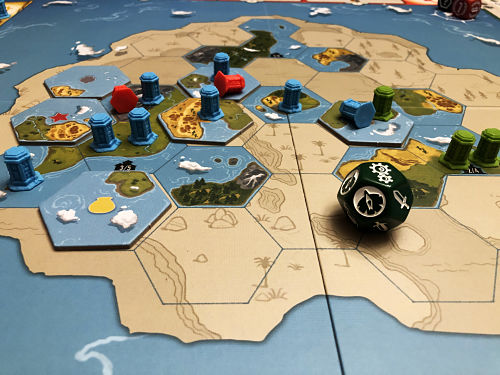
The game ends after everyone has taken their fifth income turn. The player with the most points wins. If you have already taken your fifth income turn and other players have not, they continue playing until they have completed it as well.
There are, essentially, two things you can do on your turn:
- Gain income
- Advance on a track
Gaining income is how you start the game (since you have nothing to your name but a loin cloth and a makeshift club). The only thing you do on your first income turn is to gain income, but you can follow the handy chart on the left of your income board to see what to do and when to do them.
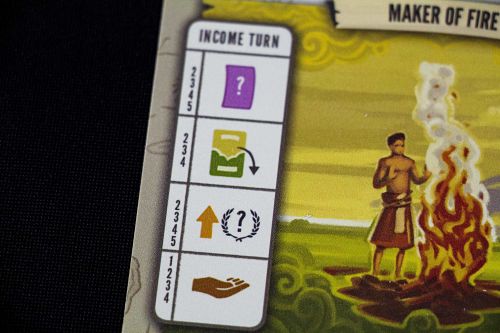
Income Turn
This is what you’ll do during the income turn:
- Activate your civilization’s ability (if applicable)
- This can give you certain perks and help you get a step up for the upcoming round.
- Play a tapestry card on the left-most uncovered space (i.e. to the right of the guy making fire)
- Tapestry cards will give you a bonus of some sort. Throughout the rounds, you can acquire a number of these cards, so hopefully you will have enough to make a good choice for how your civ is doing. If you’re the first to take an income phase for a particular era, then you get the bonus attached to it. Some tapestry cards are Trap cards; these are used to foil an opponent’s attempt at conquering one of your territories on the main map.
- Upgrade a technology and gain points
- This one is optional (although if you can, you probably should, unless you have a very good reason to not upgrade…or can’t). You choose one of your tech cards and move it up a row, gaining the ability of that tech granted by the new row (i.e. circle or square). These cards also give you points during this phase, so it’s always nice to have a few on hand.
- After placing buildings from your income mat, you will reveal various symbols. If you reveal any points, gain those points now. Points can come from tech cards, controlled territories, completed rows and columns on your capital city mat, and for their face-value as shown on the income mat.
- Gain income
- After building buildings from your income mat, you will have revealed various symbols. For each revealed symbol or icon, gain one of that resource (i.e. tapestry card, territory tile, or one of the four resources—coins, workers, food, and culture).
- On your first income turn (the very first turn of the game), this is the only step you will take. Meaning, you will only get what is already visible (the spaces on the far left of each track).
After your fifth income turn, your game is over. The game ends once all players have taken their fifth income phase.
Advance on a Track
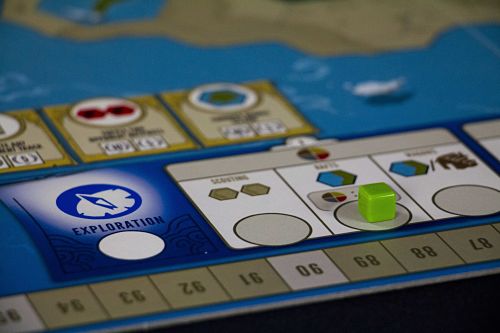
This is the core of the game. There are four tracks: Science, Technology, Exploration, and Military. When it’s your turn, you simply choose one of your player tokens and move it up one space on the track of your choosing (after paying the cost, of course). The further up the track you get, the better the bonuses, but the more resources it will cost.
Each track has a different focus (i.e. Exploration focuses on exploration tiles, military focuses on conquering others, etc.). One of the thing that I love about Tapestry is all of the decisions you can make on your turn. I’m always of the disposition to spread out my advancements evenly, but in Tapestry, you’ll want to focus on one or two tracks to begin with. As there are so many spaces throughout the four tracks, you’ll be hard pressed to complete them all.
Advancing will give you benefits, such as exploration tiles (gain and place, and placing gives points), tapestry cards, tech cards, resources, placing a building from your income track, gaining a landmark, and various other things to help spur you along to victory.
There is a lot to discuss about this part of the game, but I will refrain. The rule book gives a good rundown on what to expect, so if you’re interested, you can take a look at that.
Thoughts on Gameplay
It’s slick. It’s quick. And it’s not as difficult as all the iconography makes it out to be. I particularly enjoy all the options available to get points. If I wanted, I could go map heavy and collect exploration tiles from the exploration track, then go a-conquering from the military track. Or I could get tech and conquer. Or I could use the science track to help bolster my other tracks, among other things.
Each track lets you place a specific building, and underneath those buildings are bonuses during the income turn. So you want to reveal those by placing buildings, but you also want to get further ahead on certain tracks so as to claim the landmarks before anyone else, and…ahhh!
There’s a lot to think about, and yet the design is done in such a way that it’s not overwhelming (contrary to what my “ahhh!” might have led you to believe). Don’t be surprised if your score goes over 200, or even 300.

With lots of ways to score points, you’ll want to have a gameplay from the start. Even then, that plan can change as you add new tapestries to your civilization. The more I play Tapestry, the more I appreciate it and enjoy it. There’s a lot to explore (not even speaking of the explore track…) and digest, but it’s a good kind of buffet, one that leaves you wanting more because you’re already full but haven’t made it to the other buffet stations yet.
You’ll be back.
Solo Play
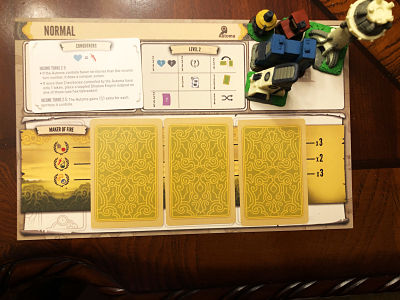
Like all Stonemaier Games games (I like saying that), the solo variant is derived from a deck of Automa cards, designed by Automa Factory. They’ve done an excellent job in games past, and Tapestry is no exception. In fact, I’m beginning to think Tapestry as one of my go-to solo games (when I have more time to play, at least).
When playing solo, there is an Automa player as well as a dummy Shadow Empire player. The Automa can get points, but the Shadow Empire is just there to race the tracks, collecting landmarks before you can get to them. Diabolical, if you ask me.
While I enjoy this solo variant and the Automa mechanics, controlling two AI is sometimes confusing. Not frequently, mind you, as it is done very well. But I much prefer when I only have to worry about one AI player as opposed to two. But, at the same time (here I go, all wishy washy again), once you get the hang of how the cards read and work, it’s not too bad.
Each card in the Automa deck has two parts: actions and tie breaker. When controlling the solo Automa, two cards are combined. The middle images are what you use—the two actions (one for the Automa and the other for the Shadow Empire) on one card, and the tie breakers on the other (the tie breakers help determine which track your opponent will advance on, as well as where they will place an exploration tile or conquer). As such, each pair of cards can give two different results in Automat actions.
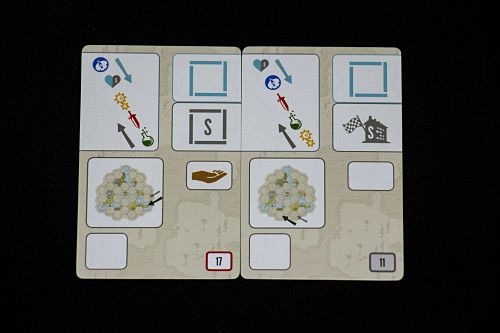
I find the Automa difficult, but not impossible, which I prefer. I’d rather have it be too difficult than too easy. All in all, the AI mechanics are smooth and well done (thanks, Automa Factory!), and this is a solo variant that simulates a multiplayer game extremely well.
In other news, you can opt to use the Shadow Empire opponent if you only have two players. This adds an extra bit of drama as there is another entity out there swiping landmarks and whatnot.
Final Thoughts
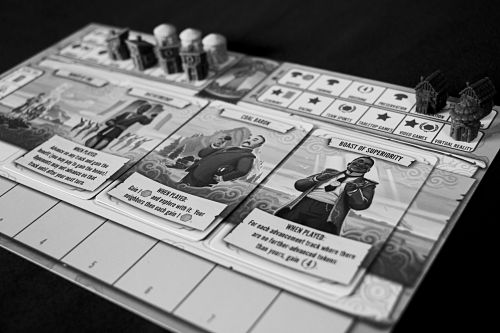
What more can be said about Tapestry? I really like it. In fact, it has quickly become a favorite solo game, which surprised me. It’s a fun take on civilization games that doesn’t feel like it has to hold to all of their pre-established “rules.” It’s a solid game for sure, and while it may look rather complicated upon first glance, the mechanics are streamlined for smooth gameplay.
Also, the review for the expansion, Plans and Ploys, is now live. Click here to read it!
Final Verdict
I really, really like Tapestry. But what to rate it? This, for me, is the tricky part, because I want to be true to the game as well as to my personal feelings toward it (it’s not you, it’s me). Fortunately, the game knows what it deserves, and that’s what I’m going to give it. So, I’m giving Tapestry a final verdict of Captivating. It is more than simply “very good.” In the end, though, Tapestry is a very, very good game. And while I greatly enjoy playing with others, I think its solo variant is what grants it the highest marks.
Verdict Scale (Lowest to Highest)
The Final Verdict is based on a scale of 1-7, although this scale is not numbered. Instead, it uses thematically appropriate words to describe the performance of the game.
Tomatoes – This game was emotionally taxing and difficult to finish.
Uninspiring – This game had me daydreaming about other games.
Lackluster – This game had its moments, but it probably won’t see much table time.
Laodicean – This game is decent. It works. There’s a reason people like it.
Two Thumbs Up – This game is very good.
Captivating – This game is outstanding! It’s more than good; it’s practically a staple.
Standing Ovation – This is the best game you will ever play. Period.
Read short fiction inspired by board games at our stories page!

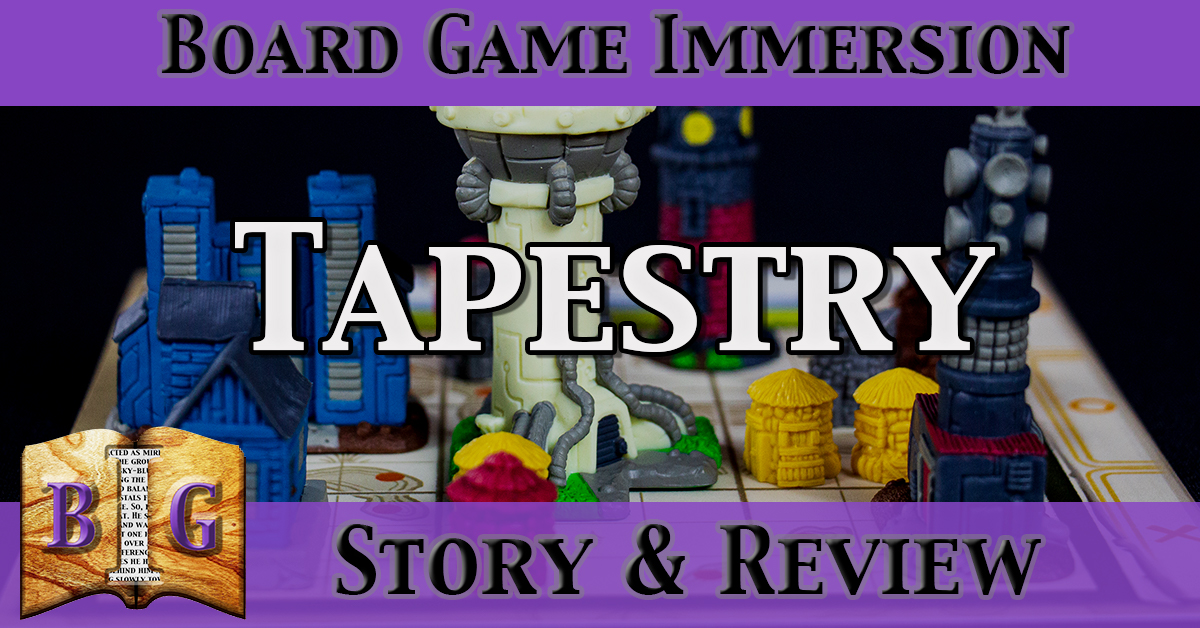


Pingback: Tapestry: Plans and Ploys Expansion Review - Board Game Immersion